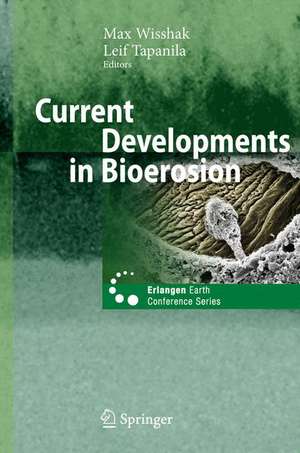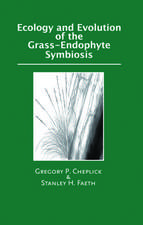Current Developments in Bioerosion: Erlangen Earth Conference Series
Editat de Max Wisshak, Leif Tapanilaen Limba Engleză Hardback – 2 iun 2008
The book opens with papers on the evolutionary significance of bioerosion, and subsequently ventures out to explore the remarkable diversity of bioerosive biota. From microboring bacteria to grazing echinoids, the studies use a variety of techniques ranging from field observations to sophisticated micro-computed tomography to investigate the ecological and environmental role of these organisms, including symbiotic interactions and alteration of non-carbonate substrates. The book concludes with a primer on the bioerosion bibliography website.
A diverse set of two dozen articles, including case studies and extensive reviews, highlight many aspects of the growing discipline of bioerosion research, from the early Palaeozoic to the present, from the Tropics to the Arctic, and from terrestrial environments to the deep-sea.
| Toate formatele și edițiile | Preț | Express |
|---|---|---|
| Paperback (1) | 1054.23 lei 38-44 zile | |
| Springer Berlin, Heidelberg – 18 noi 2010 | 1054.23 lei 38-44 zile | |
| Hardback (1) | 1064.66 lei 38-44 zile | |
| Springer Berlin, Heidelberg – 2 iun 2008 | 1064.66 lei 38-44 zile |
Preț: 1064.66 lei
Preț vechi: 1400.87 lei
-24% Nou
Puncte Express: 1597
Preț estimativ în valută:
203.72€ • 221.99$ • 171.67£
203.72€ • 221.99$ • 171.67£
Carte tipărită la comandă
Livrare economică 19-25 aprilie
Preluare comenzi: 021 569.72.76
Specificații
ISBN-13: 9783540775973
ISBN-10: 3540775978
Pagini: 516
Ilustrații: XV, 499 p. 152 illus., 18 illus. in color.
Dimensiuni: 155 x 235 x 28 mm
Greutate: 0.89 kg
Ediția:2008
Editura: Springer Berlin, Heidelberg
Colecția Springer
Seria Erlangen Earth Conference Series
Locul publicării:Berlin, Heidelberg, Germany
ISBN-10: 3540775978
Pagini: 516
Ilustrații: XV, 499 p. 152 illus., 18 illus. in color.
Dimensiuni: 155 x 235 x 28 mm
Greutate: 0.89 kg
Ediția:2008
Editura: Springer Berlin, Heidelberg
Colecția Springer
Seria Erlangen Earth Conference Series
Locul publicării:Berlin, Heidelberg, Germany
Public țintă
Professional/practitionerCuprins
Evolution and Classification.- The endolithic guild: an ecological framework for residential cavities in hard substrates.- Evolutionary implications of an exceptionally preserved Carboniferous microboring assemblage in the Buckhorn Asphalt lagerstätte (Oklahoma, USA).- Enigmatic organisms preserved in early Ordovician macroborings, western Utah, USA.- Spectrum of bioerosive biota.- The boring microflora in modern coral reef ecosystems: a review of its roles.- The trace Rhopalia clavigera isp. n. reflects the development of its maker Eugomontia sacculata Kornmann, 1960.- Colonisation and bioerosion of marine bivalve shells from the Baltic Sea by euendolithic cyanobacteria: an experimental study.- The medium is the message: imaging a complex microboring (Pyrodendrina cupra igen. n., isp. n.) from the early Paleozoic of Anticosti Island, Canada.- Micro-computed tomography for studies on Entobia: transparent substrate versus modern technology.- A history of sponge erosion: from past myths and hypotheses to recent approaches.- Substratum microtexture affects the boring pattern of Cliona albimarginata (Clionaidae, Demospongiae).- Two new dwarf Entobia ichnospecies in a diverse aphotic ichnocoenosis (Pleistocene / Rhodes, Greece).- Borings, bodies and ghosts: spicules of the endolithic sponge Aka akis sp. nov. within the boring Entobia cretacea, Cretaceous, England.- Role of polychaetes in bioerosion of coral substrates.- Parapholas quadrizonata (Spengler, 1792), dominating dead-coral boring bivalve from the Maldives, Indian Ocean.- Echinometrid sea urchins, their trophic styles and corresponding bioerosion.- Symbiotic interactions.- Boring a mobile domicile: an alternative to the conchicolous life habit.- Biogeographical distribution of Hyrrokkin (Rosalinidae, Foraminifera)and its host-specific morphological and textural trace variability.- Endolithic sponge versus terebratulid brachiopod, Pleistocene, Italy: accidental symbiosis, bioclaustration and deformity.- Spectrum of substrates.- Micro-bioerosion in volcanic glass: extending the ichnofossil record to Archaean basaltic crust.- Microbial bioerosion of bone – a review.- Xylic substrates at the fossilisation barrier: oak trunks (Quercus sp.) in the Holocene sediments of the Labe River, Czech Republic.- Trace fossil assemblages on Miocene rocky shores of southern Iberia.- Role of bioerosion in taphonomy: effect of predatory drillholes on preservation of mollusc shells.- An online bibliography of bioerosion references.
Textul de pe ultima copertă
A little more than forty years has past since the concept of bioerosion was formally recognised as the biological erosion of hard materials. In that time, it has become apparent from the literature that bioerosional processes affect a wide range of biological and geological systems that cross many disciplines among the sciences. This book is dedicated to crossing those traditional disciplinary boundaries to present a united and current perspective on the pattern and process of bioerosion.
The book opens with papers on the evolutionary significance of bioerosion, and subsequently ventures out to explore the remarkable diversity of bioerosive biota. From microboring bacteria to grazing echinoids, the studies use a variety of techniques ranging from field observations to sophisticated micro-computed tomography to investigate the ecological and environmental role of these organisms, including symbiotic interactions and alteration of non-carbonate substrates. The book concludes with a primer on the bioerosion bibliography website.
A diverse set of two dozen articles, including case studies and extensive reviews, highlight many aspects of the growing discipline of bioerosion research, from the early Palaeozoic to the present, from the Tropics to the Arctic, and from terrestrial environments to the deep-sea.
The book opens with papers on the evolutionary significance of bioerosion, and subsequently ventures out to explore the remarkable diversity of bioerosive biota. From microboring bacteria to grazing echinoids, the studies use a variety of techniques ranging from field observations to sophisticated micro-computed tomography to investigate the ecological and environmental role of these organisms, including symbiotic interactions and alteration of non-carbonate substrates. The book concludes with a primer on the bioerosion bibliography website.
A diverse set of two dozen articles, including case studies and extensive reviews, highlight many aspects of the growing discipline of bioerosion research, from the early Palaeozoic to the present, from the Tropics to the Arctic, and from terrestrial environments to the deep-sea.
Caracteristici
Provides a multi-disciplinary perspective of how bioerosional processes affect the huge variety of biological and geological systems, both past and present Includes supplementary material: sn.pub/extras

















